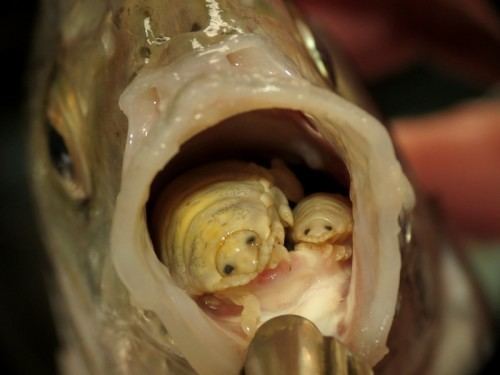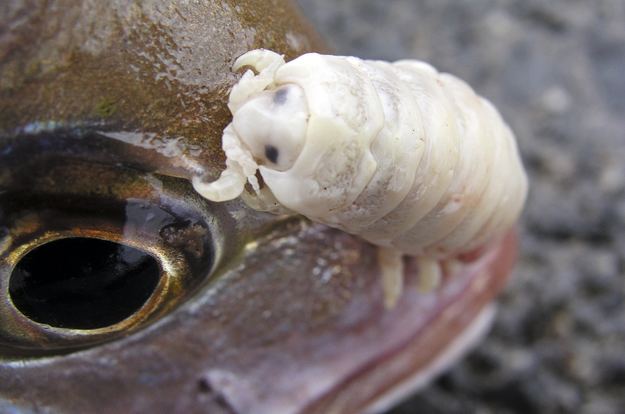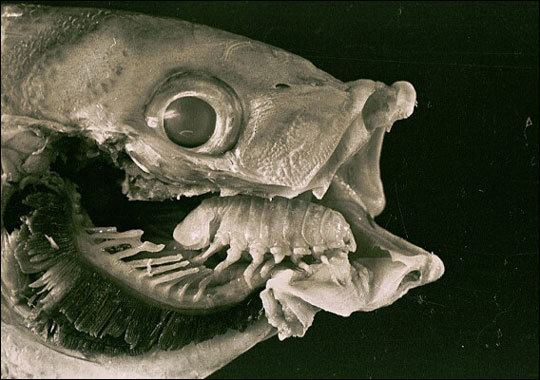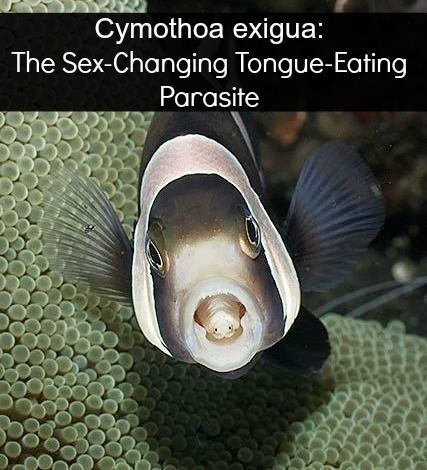Order Isopods | Genus Cymothoa Higher classification Cymothoa Rank Species | |
Similar Cymothoa, Cymothoidae, Crustacean, Isopods, Sacculina | ||
Cymothoa exigua
Cymothoa exigua, or the tongue-eating louse, is a parasitic isopod of the family Cymothoidae. This parasite enters fish through the gills, and then attaches itself to the fish's tongue. The female attaches to the tongue and the male attaches on the gill arches beneath and behind the female. Females are 8–29 millimetres (0.3–1.1 in) long and 4–14 mm (0.16–0.55 in) in maximum width. Males are approximately 7.5–15 mm (0.3–0.6 in) long and 3–7 mm (0.12–0.28 in) wide. The parasite severs the blood vessels in the fish's tongue, causing the tongue to fall off. It then attaches itself to the stub of what was once its tongue and becomes the fish's new tongue.
Contents
- Cymothoa exigua
- Cymothoa exigua project
- Behaviour
- Distribution
- Reproduction
- Influence on humans
- Popular media
- References

Cymothoa exigua project
Behaviour

C. exigua extracts blood through the claws on its front, causing the tongue to atrophy from lack of blood. The parasite then replaces the fish's tongue by attaching its own body to the muscles of the tongue stub. The fish is able to use the parasite just like a normal tongue. It appears that the parasite does not cause much other damage to the host fish, but it has been reported by Lanzing and O'Connor (1975) that infested fish with two or more of the parasites are usually underweight. Once C. exigua replaces the tongue, some feed on the host's blood and many others feed on fish mucus. This is the only known case of a parasite assumed to be functionally replacing a host organ. When a host fish dies, C. exigua will detach itself from the tongue stub after some time, leave the fish's mouth cavity, and can then be seen clinging to its head or body externally. It is not fully known what then happens to the parasite in the wild.

There are many species of Cymothoa, and only cymothoid isopods are known to consume and replace the host's organs. Other species of isopod known to parasitise fish in this way include Cymothoa borbonica and Ceratothoa imbricata.
Distribution

C. exigua is quite widespread. It can be found from the Gulf of California south to north of the Gulf of Guayaquil, Ecuador, as well as in parts of the Atlantic. It has been sampled in waters from 2 metres (6 ft 7 in) to almost 60 m (200 ft) deep. This isopod is known to parasitize eight species in two orders and four families of fishes [7 species of order Perciformes: 3 snappers (Lutjanidae), 1 species of grunt (Haemulidae), 3 drums (Sciaenidae), and 1 species of order Atheriniformes: 1 grunion (Atherinidae)]. Females of this isopod were found in the mouths of three species of snappers. New hosts from Costa Rica include the Colorado snapper, Lutjanus colorado and Jordan's snapper, L. jordani.

In 2005, a red snapper parasitized by what could be Cymothoa exigua was discovered in the United Kingdom. As the parasite is normally found off the coast of California, this led to speculation that the parasite's range may be expanding; however, it is also possible that the isopod traveled from the Gulf of California in the snapper's mouth, and its appearance in the UK is an isolated incident.
The parasite was also observed in The Gulf of Mexico near Sanibel Island in Southwest Florida in July 2016.
Reproduction
Not much is known about the life cycle of C. exigua. It exhibits sexual reproduction. It is likely that juveniles first attach to the gills of a fish and become males. As they mature, they become females, with mating likely occurring on the gills. If there is no female present, within a pair of two males, one male can turn into a female after it grows to 10 millimetres (0.4 in) in length. The female then makes its way to the fish's mouth where it uses its front claws to attach to the fish's tongue.
Influence on humans
It is currently believed that C. exigua are not harmful to humans unless picked up alive, in which case they can bite.
In Puerto Rico, C. exigua was the leading subject of a lawsuit against a large supermarket chain. The isopod C. exigua is found in snappers from the Eastern Pacific which are shipped worldwide for commercial consumption. The customer in the lawsuit claimed to have been poisoned by eating an isopod cooked inside a snapper. This case, however, was dropped on the grounds that isopods are not poisonous to humans and some are even consumed as part of a regular diet.
Popular media
C. exigua was depicted in the 2012 film The Bay, in which the residents of a small town on Chesapeake Bay were infected by the parasite, and died as a result. The film proposed that C. exigua grew to large sizes quickly due to the steroid-laden chicken feces dumped in the bay.
In The Apocalypse Codex by Charles Stross, a pseudo-Christian apocalyptic sect takes over human beings by implanting giant cymothoans provided by a malignant entity into their mouths, where they take over the function of the tongue while controlling the victim's mind.
The UK TV series QI discussed the C. exigua in episode 7 of the H series.
